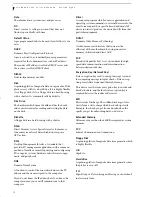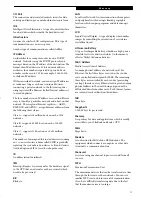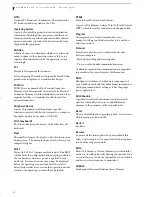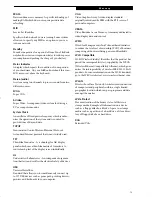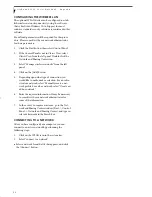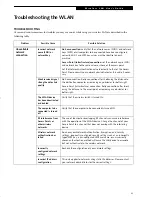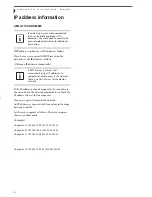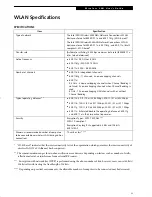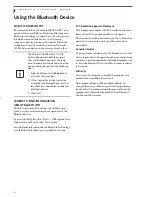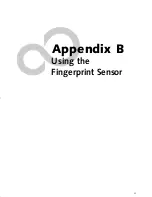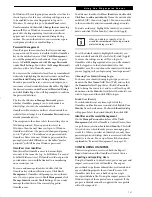
86
L i f e B o o k A 6 0 0 0 S e r i e s N o t e b o o k - A p p e n d i x
Before Using the Wireless LAN
This manual describes the procedures required to prop-
erly set up and configure the integrated Wireless LAN
Mini-PCI device (referred to as "WLAN device" in the
rest of the manual). Before using the WLAN device, read
this manual carefully to ensure it's correct operation.
Keep this manual in a safe place for future reference.
Wireless LAN Device Covered by this Document
This document is applicable to systems containing one
of the following WLAN devices:
■
Intel PRO/Wireless 3945ABG Network Connection
(WM3945ABG)
■
Intel Wireless WiFi Link 4965AGN (4965AGN)
Characteristics of the WLAN Device
■
The WLAN device is a Mini-PCI card attached to the
main board of the mobile computer.
■
The WLAN device operates in license-free RF bands,
eliminating the need to procure an FCC operating
license. The WLAN operates in the 2.4GHz Industrial,
Scientific, and Medical (ISM) RF band and the lower,
middle, and upper bands of the 5GHz Unlicensed
National Information Infrastructure (UNII) bands.
■
The Intel PRO/Wireless 3945ABG WLAN device is
capable of three operating modes, IEEE802.11a,
IEEE802.11b and IEEE802.11g.
■
The Intel PRO/Wireless 3945ABGN WLAN device is
capable of four operating modes, IEEE802.11a,
IEEE802.11b, IEEE802.11g, and IEEE802.11n (draft)
■
The WLAN device is Wi-Fi certified and operates at a
the maximum data rate of 540 Mbps (theoretical) in
IEEE802.11n (draft) mode; 54 Mbps in IEEE802.11a
or IEEE802.11g mode; and 11 Mbps in IEEE802.11b
mode.
■
The WLAN device supports the following encryption
methods - WEP, TKIP, CKIP, and AES encryption.
■
The Wireless LAN device is compliant with the follow-
ing standards: WPA, WPA2, CCX1.0, CCX2.0,
CCX3.0, and CCX4.0..
WIRELESS LAN MODES USING THIS DEVICE
Ad Hoc Mode
(See Figure A-1)
"Ad Hoc Mode" refers to a wireless
network architecture where wireless network connec-
tivity between multiple computers is established without
a central wireless network device, typically known as
Access Point(s). Connectivity is accomplished using only
client devices in a peer-to-peer fashion. That is why Ad
Hoc networks are also known as peer-to-peer networks.
Ad Hoc networks are an easy and inexpensive method
for establishing network connectivity between multiple
computers.
Ad Hoc mode requires that the SSID, network authenti-
cation, and encryption key settings are identically
configured on all computers in the Ad Hoc network.
Access Point (Infrastructure) Mode
(See Figure A-2)
Infrastructure mode refers to a wireless
network architecture in which devices communicate
with wireless or wired network devices by communi-
cating through an Access Point. In infrastructure mode,
wireless devices can communicate with each other or
with a wired network. Corporate wireless networks
operate in infrastructure mode because they require
access to the WLAN in order to access services, devices,
and computers (e.g., file servers, printers, databases).
Figure A-1. Ad Hoc Mode Network
ferret.book Page 86 Monday, April 23, 2007 1:32 PM
Summary of Contents for Lifebook A6030
Page 1: ...Fujitsu LifeBook A6030 Notebook User s Guide ...
Page 2: ......
Page 8: ...L i f e B o o k A 6 0 0 0 S e r i e s N o t e b o o k ...
Page 9: ...1 Preface ...
Page 10: ...L i f e B o o k A 6 0 0 0 S e r i e s N o t e b o o k ...
Page 12: ...2 L i f e B o o k A 6 0 0 0 S e r i e s N o t e b o o k ...
Page 13: ...3 2 Getting to Know Your LifeBook Notebook ...
Page 14: ...4 L i f e B o o k A 6 0 0 0 S e r i e s N o t e b o o k S e c t i o n T w o ...
Page 31: ...21 3 Getting Started ...
Page 32: ...22 L i f e B o o k A 6 0 0 0 S e r i e s N o t e b o o k S e c t i o n T h r e e ...
Page 39: ...29 4 User Installable Features ...
Page 40: ...30 L i f e B o o k A 6 0 0 0 S e r i e s N o t e b o o k S e c t i o n F o u r ...
Page 54: ...44 L i f e B o o k A 6 0 0 0 S e r i e s N o t e b o o k S e c t i o n F o u r ...
Page 55: ...45 5 Troubleshooting ...
Page 56: ...46 L i f e B o o k A 6 0 0 0 S e r i e s N o t e b o o k S e c t i o n F i v e ...
Page 70: ...60 L i f e B o o k A 6 0 0 0 S e r i e s N o t e b o o k S e c t i o n F i v e ...
Page 71: ...61 6 Care and Maintenance ...
Page 72: ...62 L i f e B o o k A 6 0 0 0 S e r i e s N o t e b o o k S e c t i o n S i x ...
Page 76: ...66 L i f e B o o k A 6 0 0 0 S e r i e s N o t e b o o k S e c t i o n S i x ...
Page 77: ...67 7 System Specifications ...
Page 78: ...68 L i f e B o o k A 6 0 0 0 S e r i e s N o t e b o o k S e c t i o n S e v e n ...
Page 83: ...73 8 Glossary ...
Page 84: ...74 L i f e B o o k A 6 0 0 0 S e r i e s N o t e b o o k S e c t i o n E i g h t ...
Page 92: ...82 L i f e B o o k A 6 0 0 0 S e r i e s N o t e b o o k S e c t i o n E i g h t ...
Page 93: ...83 Appendix A Integrated Wireless LAN User s Guide ...
Page 94: ...84 L i f e B o o k A 6 0 0 0 S e r i e s N o t e b o o k A p p e n d i x ...
Page 105: ...95 Appendix B Using the Fingerprint Sensor ...
Page 106: ...96 L i f e B o o k A 6 0 0 0 S e r i e s N o t e b o o k ...
Page 114: ...104 L i f e B o o k A 6 0 0 0 S e r i e s N o t e b o o k ...
Page 118: ...108 L i f e B o o k A 6 0 0 0 S e r i e s N o t e b o o k I n d e x ...
Page 119: ......
Page 120: ......





